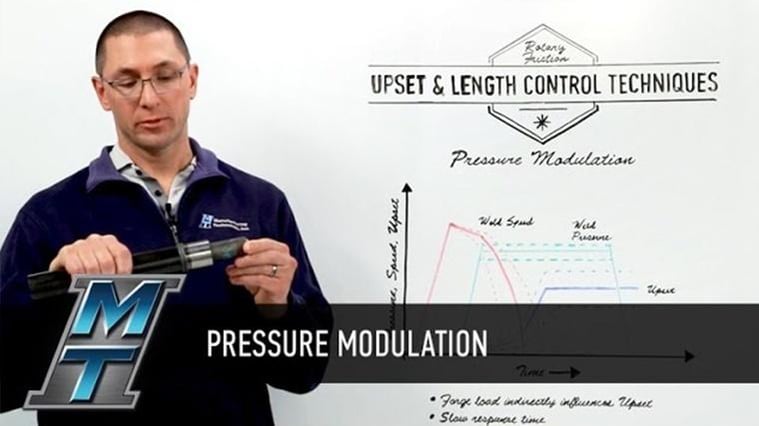
When it comes to friction welding, we want to work towards repeatability, even when there are incoming part variations. But how can we do that? One way is through pressure modulation.
Defining Upset: A Quick Review
In previous Whiteboard Wednesdays, we learned that upset is the amount of shortening of the two parts as a result of friction welding.
We also learned that if we have perfect incoming parts, we can use the same amount of energy on every weld to achieve repeatability of upset every time. But if we rely solely on fixed energy to control upset, we can’t correct for incoming part differences.
It’s All about Weld Load
By altering our weld load, we can control energy conversion. For example, as we increase our weld load, we see an increase in upset because we’re converting energy faster. Likewise, if we decrease the amount of weld load, we see less upset in the weld because we’re converting the energy slower.
Closing the Loop
Using this same principle, let’s look at an upset control technique developed by Bryan L. Benn of Rolls Royce.
Benn’s technique, known as pressure modulation, introduces an error signal into the welding process to “close the loop.” Here’s how…
Step 1: Creating an Upset Profile
First, we need to create an upset profile. To do so, we perform a standard inertia weld without the use of control techniques and record the amount of upset over time.
Step 2: The Required Weld
Afterward, we perform a separate inertia weld, or our required weld, but this time using upset control techniques.
Step 3: Generating an Error Signal
We then compare our upset profile to our required weld in order to generate an error signal. In other words, the error signal is the difference between the current weld and the weld profile.
To minimize the variation in upset part after part, the error signal provides feedback to the welding control system, which then adjusts weld pressure until we have zero error signal between the baseline and required weld profiles. Weld pressure is the machine variable we use to generate weld load because the machine uses a hydraulic cylinder, and pressure is easier to measure than the resulting force. The weld pressure, times the hydraulic cylinder area, gives us the load.
WELD PRESSURE * HYDRAULIC CYLINDER AREA = WELD LOAD
If our parts are getting too little upset, for example, the error signal alerts the control system to increase the weld pressure. In turn, we end up with just the right amount of upset. Thus, we’re closing the loop.
Keep in Mind the Error Band
Even with this effective technique, weld repeatability still has an error band associated with it. Why? The slow response time of the hydraulic control system limits the number of adjustments we can make during the friction weld.
In addition to that, the part contact tooling can make it difficult to measure the upset. If our tooling uses a fixed backstop, then the tooling compression will be minimal. But if we’re using a thrust-augmented collet clamp, for example, then as thrust increases, the tooling compression will increase, altering our reference measurement point for upset.
Room for Improvement
Despite these concerns, pressure modulation is still an effective method for controlling upset and can be used in inertia friction welding, direct drive friction welding, and rotary hybrid friction welding processes.
Stay tuned for our next episode of Whiteboard Wednesday where we’ll discuss a closed loop control technique that responds 10 times faster than pressure modulation.
MTI Can Solve Your Problems
Our expert engineers have a deep understanding of friction welding processes and the wide variety of materials that can be used. With our knowledge and machinery, we know how to achieve the maximum utilization of each material to ensure you get the highest quality parts that are perfectly catered to your applications. We’ll build a machine that makes your part, we’ll make the part for you, or we’ll help you make the part even better.
 MTI UK
MTI UK  FWT
FWT